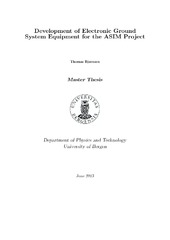| dc.description.abstract | ASIM (Atmosphere Space Interaction Monitor) is an instrument designed to monitor X-ray and gamma-ray bursts of terrestrial origin. ASIM is divided into two parts; Modular X-ray and Gamma-ray Sensor detect photons in the 15 keV to 20 MeV range, and Modular Multi-spectral Imaging Array takes images in the visible range. It will be mounted on the International Space Station (ISS) where it will be observing the earth's atmosphere. The instrument is composed of two detector layers, each consisting of four identical units. The outermost layer is a low energy detector detecting photons ranging from 15 keV to 400 keV. This layer is made out of Cadmium Zinc Telluride (CZT) crystals and structured as a pixlated array. Each unit consists of 4096 pixels, giving the MXGS a total of 16384 pixels. The innermost layer is a high energy detector detecting photons ranging from 200 keV to 20 MeV. This layer is made out of Bismuth Germanate Oxide (BGO) crystals, and each unit consists of 3 BGO crystals and 3 photomultiplying tubes. University of Bergen (UoB) is responsible for the development of both detector layers. The project is entering the final stage where the detector units are tested. Some test equipment and computer software is required to carry out these tests. This thesis describes the development of tools needed to test the detectors. A primary objective of this work was to develop the equipment with scalabil- ity and reusability in mind. Several parts of the equipment can be adapted for later projects, thus reducing the time required to develop future testing equipment. The test equipment is divided into two parts, and a computer program commands, monitors and gathers data from the detectors. All 4096 pixels of a CZT detector can be controlled individually by using a graphical user interface or through a script. The second part of the equipment is a physical interface, allowing a computer to communicate with the detectors. This is realized with a commercial FPGA based interface and with an embedded microcontroller supplying USB protocol. The primary objective is to convert from USB signals to the xlink protocol utilized by the detectors, but it also includes a buffer for temporary data storage. The system has been subject of thorough testing, including both valida- tion and verification tests and performance tests. It controls, monitors and acquires data from up to four detectors simultaneously. A working proof of concept existed a few weeks after project start, and the system has been used for several months. | en_US |
